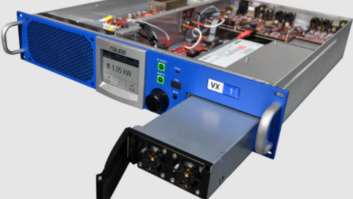The Portable Satellite Receiver Offers Improved Reception, MP3 Functionality, But Lacks Battery Life
(click thumbnail)
It was late at night on the Fourth of July, 2004, when I knew I was seriously hooked on satellite radio.
In the early afternoon of that holiday, I was due at a friend’s home. A few minutes before time to leave, I tuned in to catch a snippet of the live broadcast of Willie Nelson’s annual picnic on my new XM satellite home receiver.
That’s all it took. I immediately came under the influence of a powerful new drug. I was so addicted to the music that day I couldn’t pull away from the broadcast.
I called the friend to say I’d be a bit late. Then I called again with another delay. Finally, out of any real excuses, I gave in to the XM seduction. I never left home that day, staying glued to Willie’s live show until it ended sometime in the wee hours of the next morning.
With Samsung’s new Helix XM2go portable satellite receiver, such bizarre conduct is no longer necessary. Now, I can be obsessed anywhere with Willie’s show this July 4 on perhaps the coolest portable satellite radio ever made.
Travelin’ light
Weighing in at only 4.5 ounces and smaller than most iPods, this gadget means the days of being stuck near a fixed home or car satellite receiver are history. Also behind us are the bulky first-generation XM2go portables, whose size, weight and cumbersome complement of accessories meant it was often left at home.
The Helix is a genuine leap forward in portable satellite radio technology. Unfortunately, it comes with flaws. The second-generation XM2go offers improved reception, an intuitive interface on a gorgeous color display, streamlined accessories and the dual capability of using it as an MP3 player. For a portable device, however, it has miserable battery life.
A review unit, after the recommended eight-hour initial charging period, gave us only about four hours of intermittent XM reception before shutting down. And this was with the color screen set to turn off after 30 seconds.
Product CapsuleThumbs Up
Compact, lightweight
Great reception
Color display
Dual capability as MP3 player
Records and plays back 50 hours of XM programming
1 GB of internal Flash memory
Thumbs Down
Low battery life
Scant storage capacity
Not compatible with iPods
Not compatible with Macs
Price: $399.99
Fortunately, the Helix features a removable 3.7 volt, 1750 mAh lithium ion battery cartridge. Batteries can be easily swapped in the field. But having to take an extra battery with you for less than a day’s use is a real hassle.
Not satisfied at just being a great portable XM receiver, the Helix gets into trouble when it tries to be a generic portable music player. The Helix is no challenge to Apple’s iPod, and it will only make iPod users wish Apple and Samsung had gotten together beyond their current Flash memory deal to integrate the Helix XM receiver circuitry into the existing iPod.
Such flaws are unfortunate, because as a standalone portable XM receiver, the Helix is a killer product. It includes the ability to record and playback 50 hours of XM programming in its 1 GB of internal Flash memory. Having a stash of favorites on board when you’re out of range of satellite reception is a good idea.
The Helix has the ability to store XM content by song, channel or scheduled session. A feature I especially like is the capability to record an individual song in its entirety after it starts playing on XM. This is due to a memory buffer that stores the beginning of each song.
A feature called TuneSelect alerts the listener to a favorite artist or song whenever it is played on any XM channel. Also, there is an integrated, wireless FM transmitter for beaming XM programs to any FM radio frequency. That’s useful for auto travel.
The Flash memory in the Helix can be split in half to store – beyond XM content – both MP3 and WMA audio files. That sounds like a nice feature, but in reality it’s limited.
Not only is that scant storage capacity, but in use the music player functionality of the Helix lacks the elegance and easiness of, and compatibility with, Apple’s iPod – the gold standard for portable music technology.
To manipulate the Helix for non-XM music play, users needs to attach the device via USB to a Windows PC (sorry Mac users, there’s zero compatibility). Samsung supplies a special Windows application that controls the Helix playlist and ties it to the XM + Napster online music service. Songs bookmarked on the Helix can later be purchased through Napster.
To put it politely, the new legal version of Napster is no iTunes, having a far more limited choice of available music. Users also are required to use the software to rip their own CDs and load the songs to the Helix.
Samsung’s failure to give the Helix compatibility with the iPod, the world’s dominant portable music format, limits its functionality as a personal music player. However, the Helix shines in its primary function as an XM portable receiver. Throughout New York City, I found the tiny receiver to work well almost everywhere, either through satellite reception or one of XM terrestrial radio transmitters. Only occasionally – such as in an underground restaurant – did I lose the XM signal entirely.
Its tiny size, elegant interface, internal recording capability and good sonic quality make the Helix a joy to use. I just wish it had reasonable battery life (at least 15 real-world hours) and full integration with my large iPod library.
Until it does, I – like many others – will be forced to carry two portable music devices if I want XM plus my personal music collection while on the go.
The Samsung Helix comes with a home docking station, battery charger, case and ear buds. The car kit is optional. Retail price is $399.99. The Pioneer Inno uses the same internal electronics as the Helix, and is – beyond differences in cosmetics, software and accessories – an almost identical device.













